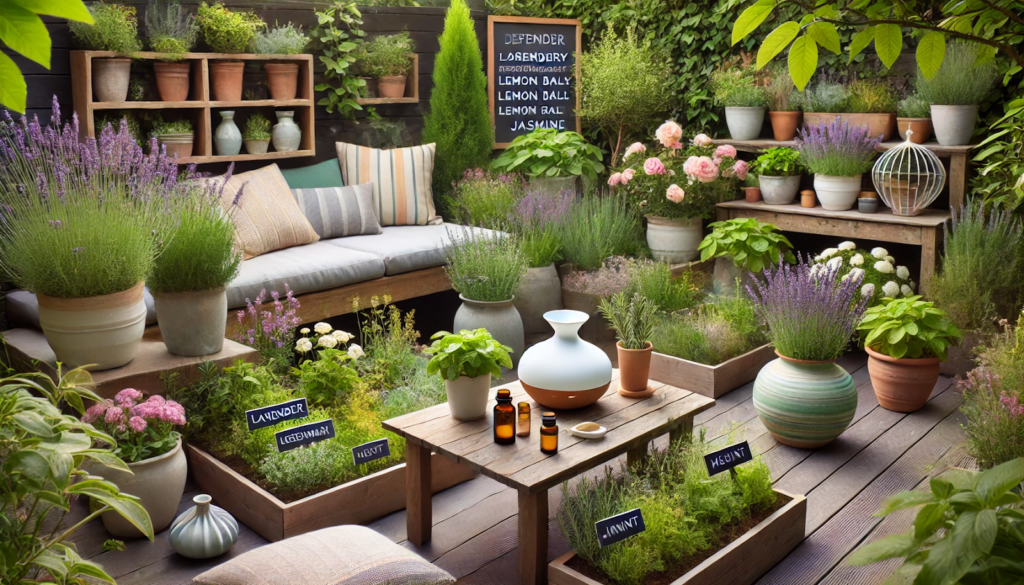An aromatherapy garden is a peaceful retreat designed to soothe the senses through scent. By growing fragrant herbs, flowers, and shrubs, you can enjoy natural relaxation, reduce stress, and create a healing atmosphere right at home.
This guide will show you how to grow a personal aromatherapy garden—no matter the size of your space.
1. What Is an Aromatherapy Garden?
An aromatherapy garden uses plants known for their calming, uplifting, or therapeutic scents. The aroma is released through oils in the leaves, flowers, and stems, activated by touch, warmth, or gentle breezes.
Benefits:
- Reduces stress and anxiety
- Improves sleep and focus
- Supports emotional well-being
- Adds natural fragrance to your space
It’s like planting your own spa.
2. Best Plants for Aromatherapy Gardens
A. Lavender
- Calming, floral scent
- Aids sleep and reduces anxiety
- Grows in full sun and well-drained soil
B. Rosemary
- Uplifting, herbal aroma
- Stimulates memory and clarity
- Drought-tolerant and great in pots
C. Lemon Balm
- Fresh, citrus scent
- Mood booster and mild sedative
- Grows well in partial shade and moist soil
D. Mint (Spearmint or Peppermint)
- Cool, invigorating scent
- Helps clear the mind and reduce headaches
- Best in containers (it spreads fast)
E. Jasmine
- Sweet, rich fragrance
- Promotes relaxation and romance
- Prefers warmth and partial sun
Other great options: Chamomile, thyme, basil, scented geranium, eucalyptus (in pots).
3. Choosing the Right Location
An aromatherapy garden doesn’t require much space—it can thrive on a balcony, patio, courtyard, or window box.
Site Tips:
- Choose a spot with good air circulation to spread scent
- Morning sun with afternoon shade is ideal for most plants
- Place near windows, doorways, or seating areas for easy enjoyment
4. Garden Layout and Design Tips
Create a peaceful environment that encourages relaxation.
Ideas:
- Use raised beds or containers for herbs
- Add a small bench or cushions for sitting and relaxing
- Incorporate gravel paths or wood chips for a natural feel
- Add wind chimes, water features, or soft lighting
- Label your herbs with markers or signs
Think of your garden as both a sensory space and a sanctuary.
5. Harvesting and Using Aromatherapy Herbs
Many aromatherapy herbs can be used fresh or dried.
How to Use:
- Cut and dry herbs for tea, sachets, or potpourri
- Infuse into oils for massage or skincare
- Use fresh sprigs in baths or tucked into pillows
- Crush leaves gently between your fingers to release scent
You can also pair your garden with a diffuser and essential oils for year-round benefits.
6. Maintenance and Care Tips
Aromatherapy gardens are easy to maintain with a little routine.
- Water regularly, especially in hot weather
- Prune herbs to encourage bushier growth
- Harvest often to keep plants fresh
- Watch for pests like aphids or powdery mildew
- Replant annuals each season (like chamomile or basil)
Mulch helps retain moisture and suppress weeds.
7. Indoor Aromatherapy Gardens
Limited on outdoor space? No problem.
Indoor Growing Tips:
- Use sunny windowsills or grow lights
- Choose small pots with drainage
- Try lavender, mint, basil, and thyme indoors
- Use aromatic clippings around your home
Even a small shelf of fragrant herbs can bring calm into your daily life.
Conclusion: Let Nature Soothe You
An aromatherapy garden is more than just pretty—it’s therapeutic. Whether you’re sipping lemon balm tea, inhaling the scent of jasmine, or simply sitting among your plants, this garden nurtures your mind as much as your body.
Start with a few fragrant favorites, design a relaxing corner, and let your garden become your go-to place for peace.






